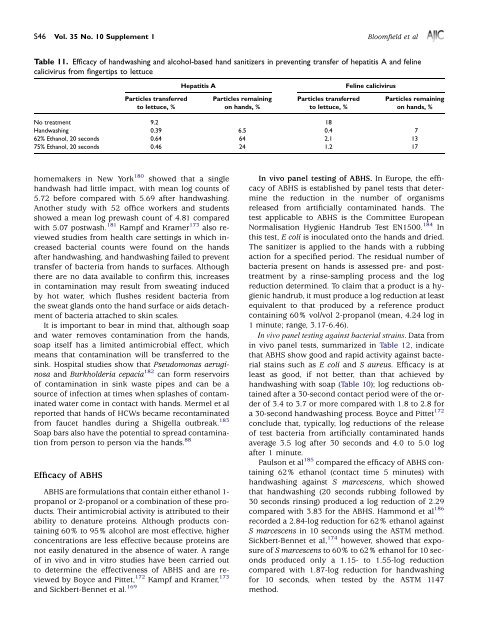The effectiveness of hand hygiene procedures in reducing the risks ...
The effectiveness of hand hygiene procedures in reducing the risks ...
The effectiveness of hand hygiene procedures in reducing the risks ...
Create successful ePaper yourself
Turn your PDF publications into a flip-book with our unique Google optimized e-Paper software.
S46 Vol. 35 No. 10 Supplement 1 Bloomfield et alTable 11. Efficacy <strong>of</strong> <strong>hand</strong>wash<strong>in</strong>g and alcohol-based <strong>hand</strong> sanitizers <strong>in</strong> prevent<strong>in</strong>g transfer <strong>of</strong> hepatitis A and fel<strong>in</strong>ecalicivirus from f<strong>in</strong>gertips to lettuceHepatitis AFel<strong>in</strong>e calicivirusParticles transferredto lettuce, %Particles rema<strong>in</strong><strong>in</strong>gon <strong>hand</strong>s, %Particles transferredto lettuce, %Particles rema<strong>in</strong><strong>in</strong>gon <strong>hand</strong>s, %No treatment 9.2 18Handwash<strong>in</strong>g 0.39 6.5 0.4 762% Ethanol, 20 seconds 0.64 64 2.1 1375% Ethanol, 20 seconds 0.46 24 1.2 17homemakers <strong>in</strong> New York 180 showed that a s<strong>in</strong>gle<strong>hand</strong>wash had little impact, with mean log counts <strong>of</strong>5.72 before compared with 5.69 after <strong>hand</strong>wash<strong>in</strong>g.Ano<strong>the</strong>r study with 52 <strong>of</strong>fice workers and studentsshowed a mean log prewash count <strong>of</strong> 4.81 comparedwith 5.07 postwash. 181 Kampf and Kramer 173 also reviewedstudies from health care sett<strong>in</strong>gs <strong>in</strong> which <strong>in</strong>creasedbacterial counts were found on <strong>the</strong> <strong>hand</strong>safter <strong>hand</strong>wash<strong>in</strong>g, and <strong>hand</strong>wash<strong>in</strong>g failed to preventtransfer <strong>of</strong> bacteria from <strong>hand</strong>s to surfaces. Although<strong>the</strong>re are no data available to confirm this, <strong>in</strong>creases<strong>in</strong> contam<strong>in</strong>ation may result from sweat<strong>in</strong>g <strong>in</strong>ducedby hot water, which flushes resident bacteria from<strong>the</strong> sweat glands onto <strong>the</strong> <strong>hand</strong> surface or aids detachment<strong>of</strong> bacteria attached to sk<strong>in</strong> scales.It is important to bear <strong>in</strong> m<strong>in</strong>d that, although soapand water removes contam<strong>in</strong>ation from <strong>the</strong> <strong>hand</strong>s,soap itself has a limited antimicrobial effect, whichmeans that contam<strong>in</strong>ation will be transferred to <strong>the</strong>s<strong>in</strong>k. Hospital studies show that Pseudomonas aerug<strong>in</strong>osaand Burkholderia cepacia 182 can form reservoirs<strong>of</strong> contam<strong>in</strong>ation <strong>in</strong> s<strong>in</strong>k waste pipes and can be asource <strong>of</strong> <strong>in</strong>fection at times when splashes <strong>of</strong> contam<strong>in</strong>atedwater come <strong>in</strong> contact with <strong>hand</strong>s. Mermel et alreported that <strong>hand</strong>s <strong>of</strong> HCWs became recontam<strong>in</strong>atedfrom faucet <strong>hand</strong>les dur<strong>in</strong>g a Shigella outbreak. 183Soap bars also have <strong>the</strong> potential to spread contam<strong>in</strong>ationfrom person to person via <strong>the</strong> <strong>hand</strong>s. 88Efficacy <strong>of</strong> ABHSABHS are formulations that conta<strong>in</strong> ei<strong>the</strong>r ethanol 1-propanol or 2-propanol or a comb<strong>in</strong>ation <strong>of</strong> <strong>the</strong>se products.<strong>The</strong>ir antimicrobial activity is attributed to <strong>the</strong>irability to denature prote<strong>in</strong>s. Although products conta<strong>in</strong><strong>in</strong>g60% to 95% alcohol are most effective, higherconcentrations are less effective because prote<strong>in</strong>s arenot easily denatured <strong>in</strong> <strong>the</strong> absence <strong>of</strong> water. A range<strong>of</strong> <strong>in</strong> vivo and <strong>in</strong> vitro studies have been carried outto determ<strong>in</strong>e <strong>the</strong> <strong>effectiveness</strong> <strong>of</strong> ABHS and are reviewedby Boyce and Pittet, 172 Kampf and Kramer, 173and Sickbert-Bennet et al. 169In vivo panel test<strong>in</strong>g <strong>of</strong> ABHS. In Europe, <strong>the</strong> efficacy<strong>of</strong> ABHS is established by panel tests that determ<strong>in</strong>e<strong>the</strong> reduction <strong>in</strong> <strong>the</strong> number <strong>of</strong> organismsreleased from artificially contam<strong>in</strong>ated <strong>hand</strong>s. <strong>The</strong>test applicable to ABHS is <strong>the</strong> Committee EuropeanNormalisation Hygienic Handrub Test EN1500. 184 Inthis test, E coli is <strong>in</strong>oculated onto <strong>the</strong> <strong>hand</strong>s and dried.<strong>The</strong> sanitizer is applied to <strong>the</strong> <strong>hand</strong>s with a rubb<strong>in</strong>gaction for a specified period. <strong>The</strong> residual number <strong>of</strong>bacteria present on <strong>hand</strong>s is assessed pre- and posttreatmentby a r<strong>in</strong>se-sampl<strong>in</strong>g process and <strong>the</strong> logreduction determ<strong>in</strong>ed. To claim that a product is a hygienic<strong>hand</strong>rub, it must produce a log reduction at leastequivalent to that produced by a reference productconta<strong>in</strong><strong>in</strong>g 60% vol/vol 2-propanol (mean, 4.24 log <strong>in</strong>1 m<strong>in</strong>ute; range, 3.17-6.46).In vivo panel test<strong>in</strong>g aga<strong>in</strong>st bacterial stra<strong>in</strong>s. Data from<strong>in</strong> vivo panel tests, summarized <strong>in</strong> Table 12, <strong>in</strong>dicatethat ABHS show good and rapid activity aga<strong>in</strong>st bacterialsta<strong>in</strong>s such as E coli and S aureus. Efficacy is atleast as good, if not better, than that achieved by<strong>hand</strong>wash<strong>in</strong>g with soap (Table 10); log reductions obta<strong>in</strong>edafter a 30-second contact period were <strong>of</strong> <strong>the</strong> order<strong>of</strong> 3.4 to 3.7 or more compared with 1.8 to 2.8 fora 30-second <strong>hand</strong>wash<strong>in</strong>g process. Boyce and Pittet 172conclude that, typically, log reductions <strong>of</strong> <strong>the</strong> release<strong>of</strong> test bacteria from artificially contam<strong>in</strong>ated <strong>hand</strong>saverage 3.5 log after 30 seconds and 4.0 to 5.0 logafter 1 m<strong>in</strong>ute.Paulson et al 185 compared <strong>the</strong> efficacy <strong>of</strong> ABHS conta<strong>in</strong><strong>in</strong>g62% ethanol (contact time 5 m<strong>in</strong>utes) with<strong>hand</strong>wash<strong>in</strong>g aga<strong>in</strong>st S marcescens, which showedthat <strong>hand</strong>wash<strong>in</strong>g (20 seconds rubb<strong>in</strong>g followed by30 seconds r<strong>in</strong>s<strong>in</strong>g) produced a log reduction <strong>of</strong> 2.29compared with 3.83 for <strong>the</strong> ABHS. Hammond et al 186recorded a 2.84-log reduction for 62% ethanol aga<strong>in</strong>stS marcescens <strong>in</strong> 10 seconds us<strong>in</strong>g <strong>the</strong> ASTM method.Sickbert-Bennet et al, 174 however, showed that exposure<strong>of</strong> S marcescens to 60% to 62% ethanol for 10 secondsproduced only a 1.15- to 1.55-log reductioncompared with 1.87-log reduction for <strong>hand</strong>wash<strong>in</strong>gfor 10 seconds, when tested by <strong>the</strong> ASTM 1147method.


